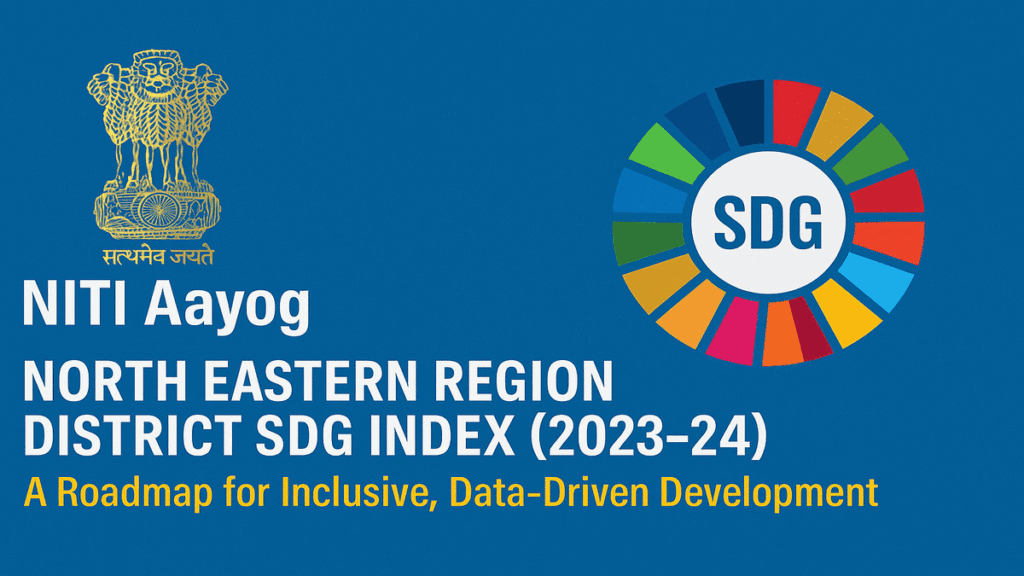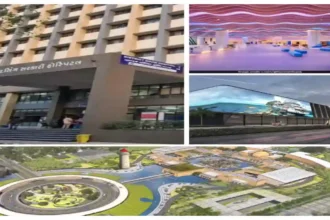
In a significant stride towards data driven governance and regional development, NITI Aayog in collaboration with the Ministry of Development of North Eastern Region (MDoNER) and UNDP India, has launched the 2nd edition of the North Eastern Region District SDG Index (2023-24). This ambitious tool aims to accelerate the pace of achieving the Sustainable Development Goals (SDGs) by evaluating district level performance across the eight northeastern states of India.
The North Eastern Region District SDG Index (2023-24) marks a bold reaffirmation of the central government’s push for inclusive development, particularly in regions traditionally considered peripheral to India’s economic and administrative mainstream.
What is the North Eastern Region District SDG Index (2023-24)?
The North Eastern Region District SDG Index (2023-24) is a composite index developed by NITI Aayog to measure progress across 115 districts in the northeastern states Arunachal Pradesh, Assam, Manipur, Meghalaya, Mizoram, Nagaland, Sikkim, and Tripura.
The Index evaluates performance across 17 SDGs, using 122 indicators aligned with national priorities. It enables state governments, district administrations, and policy researchers to identify areas of strength and concern.
“North Eastern Region District SDG Index (2023-24)” appears as a strategic tool to bridge the data gap and bolster performance monitoring at the grassroots.
Objectives and Methodology
A Tool for Targeted Development
The North Eastern Region District SDG Index (2023-24) aims to:
- Assess SDG progress at the district level using measurable indicators.
- Strengthen data based policy formulation and local governance.
- Encourage peer learning and healthy competition among districts.
- Enable identification of developmental gaps requiring urgent attention.
Methodological Approach
NITI Aayog has ensured a rigorous methodology:
- 122 indicators were chosen based on data availability, relevance, and alignment with national SDG indicators.
- Each district received a score between 0 and 100, where 100 represents full achievement of a particular SDG.
- Districts were classified into four categories: Aspirant (0–49), Performer (50–64), Front Runner (65–99), and Achiever (100).
Performance Highlights of the North Eastern Region District SDG Index (2023-24)
State-wise Overview
- Sikkim emerged as a strong performer, with districts like Gangtok consistently ranking high across multiple goals.
- Tripura demonstrated marked improvement in education, health, and infrastructure.
- Assam’s districts showed significant variation, indicating pockets of excellence as well as areas needing attention.
- Meghalaya and Nagaland registered gains in environmental sustainability and inclusive governance.
Goal wise Trends
- 1. SDG 3 (Good Health and Well-Being): Many districts in Mizoram and Manipur scored high due to better healthcare accessibility.
- 2. SDG 4 (Quality Education): Districts in Sikkim and Tripura performed well, aided by state investment in rural schools.
- 3. SDG 6 (Clean Water and Sanitation): Sikkim led in sanitation metrics, while parts of Assam lagged behind.
- 4. SDG 13 (Climate Action): All northeastern states reflected a relatively strong performance owing to rich biodiversity and conservation initiatives.
The Role of Data in Driving Development
The release of the North Eastern Region District SDG Index (2023-24) underscores how data analytics and measurement frameworks can inform better governance and targeted investments. The index highlights how district-level data can refine policy design, helping planners allocate resources efficiently and address regional disparities.
This shift toward data centric development ensures accountability and fosters transparency in government delivery systems.
NITI Aayog’s Broader Vision for Northeast India
Fulfilling the “Act East” and “Inclusive India” Vision
The North Eastern Region District SDG Index (2023-24) forms a key element of NITI Aayog’s broader vision to:
- Make Northeast a gateway to Southeast Asia.
- Integrate the region into the national growth story.
- Leverage local strengths such as biodiversity, culture, and human capital.
Importance of Localized Data in Policy Formulation
Localized data from this index will help in:
- Creating district-specific development plans.
- Allocating centrally sponsored schemes more effectively.
- Monitoring real time progress on crucial indicators like infant mortality, school enrollment, and sanitation.
Challenges Identified by the Index
While the North Eastern Region District SDG Index (2023-24) paints a progressive picture, it also exposes persistent challenges:
- Infrastructure Deficit: In many remote districts, road, digital, and energy infrastructure is below the national average.
- Migration & Employment: Lack of formal employment pushes youth migration to metros.
- Data Inconsistencies: Availability of reliable district level data still poses a problem for accurate benchmarking.
UNDP and MDoNER: Strategic Partners in SDG Acceleration
The index is the result of multi stakeholder collaboration:
- UNDP India brought international SDG measurement expertise.
- MDoNER provided regional context and operational support.
- State governments ensured alignment with local realities.
This collaborative model sets a precedent for public policy innovation that includes all tiers of governance.
Success Stories from the Region
Gangtok, Sikkim: A Model District
Gangtok stands out for:
- High literacy and school completion rates.
- Universal sanitation access.
- Low maternal and infant mortality.
Its performance in the North Eastern Region District SDG Index (2023-24) can serve as a blueprint for replication in other regions.
West Tripura: Governance and Innovation
West Tripura has improved on:
- Rural electrification.
- Gender equality in schooling.
- Agricultural productivity.
Its consistent rise in rankings reflects the potential of efficient administration combined with community participation.
Impact on Governance and Civic Engagement
By making North Eastern Region District SDG Index (2023-24) public and accessible, NITI Aayog has empowered:
- District Magistrates to set clear development targets.
- Citizens to demand better services.
- Media and civil society to hold administrations accountable.
- It is a step toward democratizing development planning.
Future Path and Recommendations
Enhancing Index Utility
- 1. Real time Dashboards: Digital platforms to display district progress live.
- 2. Open Data Access: Enable researchers and journalists to dig deeper into metrics.
- 3. SDG based Budgeting: Align state and district budgets with SDG goals.
- 4. Capacity Building: Train local officers in using SDG tools for decision making.
NITI Aayog’s Way Forward
NITI Aayog is expected to:
- Expand this model to other regions like central India and the Himalayan belt.
- Integrate feedback mechanisms from district officials and stakeholders.
- Support tech based governance for continuous SDG tracking.
Why the North Eastern Region District SDG Index (2023-24) Matters
The North Eastern Region District SDG Index (2023-24) is more than just a scorecard it is a symbol of commitment to uplift historically underserved regions. It reflects a shift in governance priorities from top down planning to hyperlocal impact measurement.
With its comprehensive data driven approach, the index ensures that no district is left behind, echoing the core philosophy of the 2030 Sustainable Development Agenda “Leave No One Behind.”
Conclusion
In essence, the North Eastern Region District SDG Index (2023-24) is a landmark step towards integrated, inclusive, and intelligent governance. It highlights how data-led policymaking can accelerate India’s SDG goals, especially in complex geographies like the Northeast.
As India enters the final stretch towards 2030, initiatives like this backed by strong political will, technological innovation, and regional cooperation will define the quality of life for millions of citizens in the country’s frontier regions.
Stay Connected for deeper insights on regional development, sustainable governance, and national policymaking, stay tuned with The News Drill.
Contact us: contact@thenewsdrill.com
Submit a tip or report a story: editor@thenewsdrill.com or visit our Contributor Page












